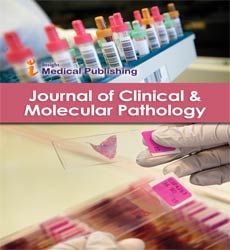ISSN : 2634-7806
Journal of Clinical and Molecular Pathology : Open Access
Leukemia in Children Pathophysiology
Hayle Martin*
Department of Oncology, Federal University of Santa, Catarina
- *Corresponding Author:
- Hayle Martin
Department of Oncology, Federal University of Santa, Catarina
Tel: 02593541259
E-mail: haylemartin11@hotmail.com
Received Date: December 07, 2021; Accepted Date: December 21, 2021; Published Date: December 28, 2021
Citation: Martin H (2021) Leukemia in Children - Pathophysiology, J Clin Mol Pathol, Vol: 5 No: 4.
Description
Leukemia is a blood cancer that is classified as a hematological malignancy. It starts in the bone marrow, which is the soft interior part of the bone where new blood cells are produced. The bone marrow of a child with leukemia creates white blood cells that do not mature properly. Normal, healthy cells can only replicate if there is enough space for them to do so. The body will control cell production by sending out signals when it is time to cease. The cells of a child with leukemia do not respond to the signals that instruct them when to cease producing cells and when to stop producing them. When the bone marrow becomes overcrowded, it becomes difficult to produce other blood cells. [Perinatal leukaemia has biological and clinical characteristics that differ greatly from leukemia in later children, and the prognosis is often poor. Neonatal with acute myelocytic leukaemia (AML) fare substantially better than those with acute lymphocytic leukaemia (ALL) once complete remission is established (ALL).
Discussion
Congenital leukemia is a rare disease with unique biochemical and clinical characteristics that set it apart from older children's leukemia. It has a bad prognosis in most cases. Hyper leukocytosis, thrombocytopenia, and organomegaly are some of the clinical manifestations, while some patients have cutaneous infiltration by leukemic cells (leukemia cutis). Childhood leukaemia is a disease of the white blood cells that is the most frequent type of cancer in children and teenagers. In the bone marrow, abnormal white blood cells form. They travel fast through the bloodstream, crowding out healthy cells in the process. This increases the risk of infection and other disorders in the body. It's comforting to know that, as difficult as it is for a child to suffer cancer, most children and teenagers with childhood leukaemia may be successfully treated.
The majority of cases of paediatric leukaemia have an unknown cause. The majority of children with leukaemia have no identified risk factors. A two-step process, commencing with a prenatal genetic mutation and subsequently virus exposure, is thought to be the aetiology of juvenile acute lymphoblastic leukaemia. There is proof that maternal alcohol intake is linked to the development of AML in children. Insecticide exposure inside has also been connected to the onset of children leukemias. Coffee drinking during pregnancy has also been related to a higher risk of paediatric leukaemia. Allergies have also been connected to the development of juvenile leukaemia, however current research does not support this theory.
Treatment for childhood leukaemia is determined by a variety of factors, including the type of leukaemia, its characteristics, prognostic characteristics (children with worse prognostic characteristics receive more aggressive therapy; see the Prognosis section), response to therapy, and the extent of the disease at the time of diagnosis. A team of health care professionals, including paediatric oncologists, social workers, paediatric nurse specialists, and doctors, is usually in charge of treatment.
Conclusion
A variety of risk factors for juvenile leukaemia have been investigated. Down syndrome, Fanconi anaemia, familial monosomy 7, Shwachman–Diamond syndrome, Bloom Syndrome, and mutations in specific gene variants are all genetic risk factors. Ionizing radiation exposure, in addition to genetic risk factors, is a known risk factor for paediatric leukaemia. Family history of blood cancers, maternal alcohol use, parental cigarette use, prior loss of pregnancy in the mother, older age of the mother, high birth weight, low birth weight, benzene exposure, pesticide exposure, and infections are all factors that may be linked to the development of childhood leukaemia. However, it is uncertain whether or how much these factors contribute to the development of leukaemia.
Open Access Journals
- Aquaculture & Veterinary Science
- Chemistry & Chemical Sciences
- Clinical Sciences
- Engineering
- General Science
- Genetics & Molecular Biology
- Health Care & Nursing
- Immunology & Microbiology
- Materials Science
- Mathematics & Physics
- Medical Sciences
- Neurology & Psychiatry
- Oncology & Cancer Science
- Pharmaceutical Sciences
